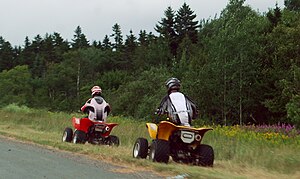 Image via Wikipedia
Image via WikipediaNot all of us can afford a brand new ATV with all the bells and whistles. As with cars or motorcycles or any large vehicle for recreation or pleasure, we sometimes have to start out with buying second hand.
Of course there’s nothing wrong with purchasing a used car, bike or ATV. If you are going to buy used, you have to know what to look for, especially with a vehicle such as an ATV where you know that there is a chance the previous owner might have given the ATV some serious abuse on the trails.
Before you begin to cruise the classifieds you have a couple of decisions to make. Who is the ATV for? An ATV for an adult is made differently than one made for a child. Do you want the ATV for purely recreational purposes? Do you want to race or just enjoy some leisurely off-roading with your family? Do you want to use the ATV as a utility vehicle?
The best place to start if you have never purchased an ATV before would be at a local dealership. You may not be able to afford one off the showroom floor, but you can still go look and pick the dealer’s brain for information. At the dealership you can ‘test’ the different classes of ATVs. Sit on a few to see how they fit, each ATV will be different and you might find that some are more comfortable than others. Even though you are trying newer models, there really won’t be too much of a difference between them and the older versions.
After getting all the information you can from the dealership, you will have some idea of what make and model you will be looking for in a used ATV. While you’re at the dealership also check to see if they have a bulletin board for other ATV resources. Sometimes if you contact a club or other organization they may be able to put you in touch with people who have ATV’s to sell.
Classified ads and specialized classified magazines like you see for cars or motorcycles will also be a valuable resource. And of course the number one source for finding used vehicles is the internet. Places like craigslist and eBay will no doubt have a lot to offer, the only problem is, unless the seller is in your area, you have no way to view the ATV up close.
When you find the ATV you want to purchase, definitely go to check it out personally. When you see the ATV for the first time, make note of the condition of the plastic on the fenders. The overall outward appearance of the ATV will give you a pretty good clue as to how hard the previous owner treated the vehicle.
If the fenders or other plastic parts are cracked and ruined you can bet that you’re going to have to replace them and replacement parts and accessories are expensive. You have to decide how much you are willing to invest in refurbishing the ATV if parts do need replacing. Check the condition of the seat for any rips or tears. Again, a ripped seat isn’t a big deal and is totally replaceable, but do you want to spend the extra money to do that?
The next part of the inspection will take some work. You will want to lift the front end of the ATV up to inspect the undercarriage. With the ATV lifted, closely inspect the frame for any damage. Make sure there are no cracks or dents in the frame or any of the connecting welds. Note any areas that might have rust and check them for cracks too.
Check the handlebars for any loose play and do the same to each wheel. Loose wheels could indicate worn wheel bearings or damaged ball joints. Oil, breaks and the air filter and air box should also be checked. Ask the owner if they have any records regarding oil changes and maintenance. Some owners might have an owner’s manual that they can pass on to you. Take the ATV for a test drive too if you can to see how it handles.
Lastly, if a title is required in your state ask the owner if they have the title and if it is clear. Most states require a bill of sale with the VIN (vehicle identification number) on it. Whether your state requires a bill of sale or not, it is always a good idea to have one to protect both you and the former owner incase a dispute crops up.
Be aware that in most cases you are buying the ATV “as is”, which means the previous owner is not responsible for any problems you might find with the vehicle after you have purchased it and brought it home.
Have fun,
Greg


![Reblog this post [with Zemanta]](http://img.zemanta.com/reblog_e.png?x-id=de60c5f2-545e-4d5b-94ee-782171611605)


No comments:
Post a Comment